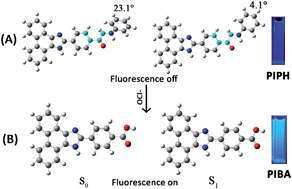A new turn-on fluorescent probe towards hypochlorite in living cells†
Abstract
A novel turn-on fluorescent sensor (PIPH) based on phenanthroimidazole derivatives was successfully designed and synthesized. The probe shows high selectivity and sensitivity towards OCl− with approximately 20-fold fluorescence enhancement at 415 nm and the detection limit was measured to be 0.58 μM. Then through NMR spectra and high-resolution mass spectrometry, it was confirmed that the phenylhydrazine group of PIPH was decomposed by OCl−. The fluorescence enhancement mechanism of the probe was further investigated by theoretical calculations. Finally, Hela cells were applied in cell imaging. It was proved that the probe has potential capacity to detect hypochlorite in vivo.



 Please wait while we load your content...
Please wait while we load your content...